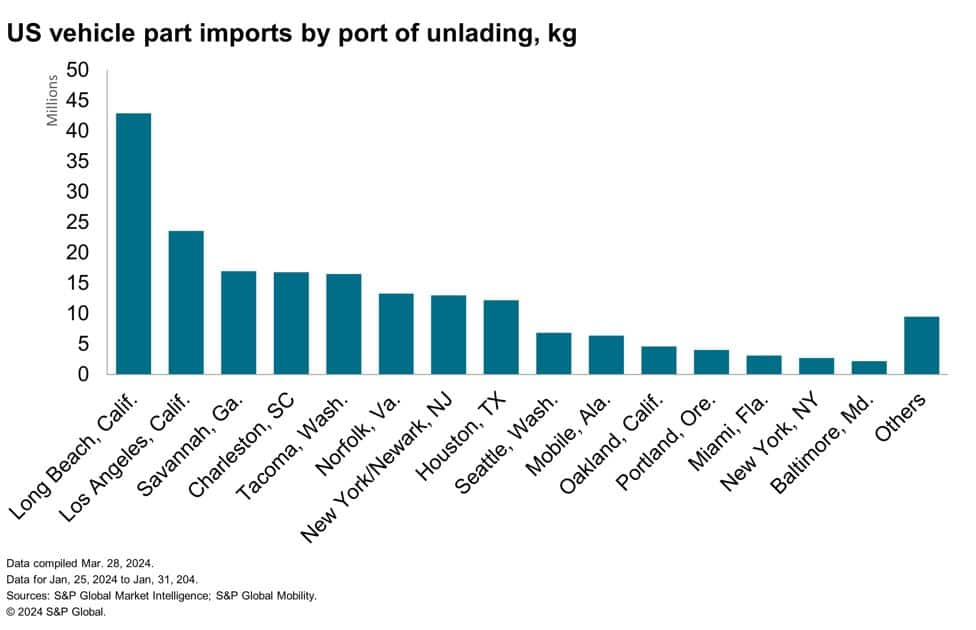Discover more about S&P Global's offerings
Customer Logins
Obtain the data you need to make the most informed decisions by accessing our extensive portfolio of information, analytics, and expertise. Sign in to the product or service center of your choice.
Customer Logins
BLOG
Apr 10, 2024
BriefCASE: Baltimore - Not another port in automotive’s stormy recent history
As the world awoke on the morning of March 26 to the news that
there had been a crash involving a container ship and the Francis
Scott Key Bridge in the city of Baltimore, which had caused the
bridge to collapse, immediate thoughts were for the safety and
welfare of all concerned. Six people are missing, presumed dead in
the tragic aftermath.
Traffic through the port will be suspended until further notice and
looks set to disrupt to trade and supply chains. One of the sectors
that would likely be affected is automotive, particularly after the
disclosure that the Baltimore port is the biggest single hub for
trade in light vehicles in the US. Will the events at Baltimore be
the latest exogenous supply chain shock to join a long list of
events to disrupt the sector since the 2011 Fukushima nuclear
disaster?
To attempt to address this question, we undertook an analysis of
recent trade data for vehicles and parts provided by Panjiva, a
product of the S&P Global Market Intelligence division. Our
vehicle analysis focuses from the Jan. 1, 2024, to Jan. 31, 2024
time period to give a snapshot of vehicle tradeflows into the US.
Using the Harmonized System (HS) code 8703, which relates to cars
and motor vehicles mainly designed for personal transportation, we
scrubbed the data for products outside of the light-vehicle sphere,
such as golf carts and all-terrain vehicles (ATVs), and used
vehicles.
This process confirmed Baltimore's crown as the leading port for
vehicle movement in the US. In the period under consideration, it
accounted for 15.2% of vehicle trade, nearly 5% ahead of its
nearest rival Brunswick, Ga. In terms of imported vehicle trade by
weight, Baltimore's figure of nearly 117,000 tons equates to nearly
63,000 vehicles based on the average weight of new vehicles in the
US, according to an Environmental Protection Agency (EPA) study of
2022.
Delving deeper into data for Baltimore and looking at consignees
(those receiving the goods) based just in North America —
leaving out those vehicles where Baltimore is just a stopping-off
point before heading further afield to countries such as Australia,
New Zealand or South Korea — it is seen that Mazda is the
biggest customer of the port in terms of vehicle trade. Mazda first
signed a five-year contract with the Port of Baltimore back in
August 2013, making the port the hub for its northeastern
distribution.
Impact on supply chain
The level of disruption caused to vehicle shipments by Baltimore's
shutdown is expected to be minimalized by a multitude of other
options being available to vehicle companies wanting to route their
vehicles to the US' east coast. Brunswick; Newark, NJ; and
Philadelphia all provide viable alternatives.
Further hope that supply chain disruption will be minimal is
provided by diving into Panjiva's data on motor vehicle parts (HS
8708 for those interested). Examining the trade data for a one-week
period in January 2024 reveals that Baltimore is a much less
significant player when it comes to original equipment (OE) and
aftermarket parts. Here, Baltimore sits 15th in the list of US
ports and had just a 1.1% share of motor part traffic in the
week.

The primary concern for the industry will center on whether any
critical parts will be impacted by Baltimore's immediate closure
with knock-on effects for vehicle production and vehicle option
availability. Here, there seems to be more good news for the
industry's supply chain. Further examination of the motor vehicle
parts data relating to Baltimore does not throw up any significant
risks. A Cummins subsidiary, Cummins Cooling Products Inc., is
noted as the consignee for intercoolers and charge air coolers
shipped from mainland China. Elsewhere, a consignment of Dana drive
axles from Italy is noted.
All told, it seems fair to say that the Baltimore port incident,
while bringing short-term disruption to the industry, does not seem
set to roil the sector in the way that the COVID-19 pandemic,
semiconductors and the war in Ukraine have in recent history.
This article was published by S&P Global Mobility and not by S&P Global Ratings, which is a separately managed division of S&P Global.
{"items" : [
{"name":"share","enabled":true,"desc":"<strong>Share</strong>","mobdesc":"Share","options":[ {"name":"facebook","url":"https://www.facebook.com/sharer.php?u=http%3a%2f%2fstage.www.spglobal.com%2fmobility%2fen%2fresearch-analysis%2fbriefcase-baltimore-not-another-port-in-automotives-history.html","enabled":true},{"name":"twitter","url":"https://twitter.com/intent/tweet?url=http%3a%2f%2fstage.www.spglobal.com%2fmobility%2fen%2fresearch-analysis%2fbriefcase-baltimore-not-another-port-in-automotives-history.html&text=BriefCASE%3a+Baltimore+-+Not+another+port+in+automotive%e2%80%99s+stormy+recent+history+++%7c+S%26P+Global+","enabled":true},{"name":"linkedin","url":"https://www.linkedin.com/sharing/share-offsite/?url=http%3a%2f%2fstage.www.spglobal.com%2fmobility%2fen%2fresearch-analysis%2fbriefcase-baltimore-not-another-port-in-automotives-history.html","enabled":true},{"name":"email","url":"?subject=BriefCASE: Baltimore - Not another port in automotive’s stormy recent history | S&P Global &body=http%3a%2f%2fstage.www.spglobal.com%2fmobility%2fen%2fresearch-analysis%2fbriefcase-baltimore-not-another-port-in-automotives-history.html","enabled":true},{"name":"whatsapp","url":"https://api.whatsapp.com/send?text=BriefCASE%3a+Baltimore+-+Not+another+port+in+automotive%e2%80%99s+stormy+recent+history+++%7c+S%26P+Global+ http%3a%2f%2fstage.www.spglobal.com%2fmobility%2fen%2fresearch-analysis%2fbriefcase-baltimore-not-another-port-in-automotives-history.html","enabled":true}]}, {"name":"rtt","enabled":true,"mobdesc":"Top"}
]}


